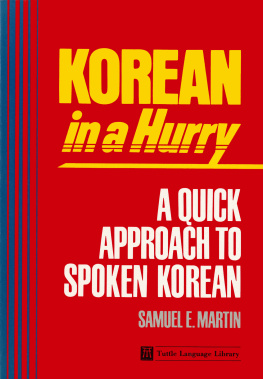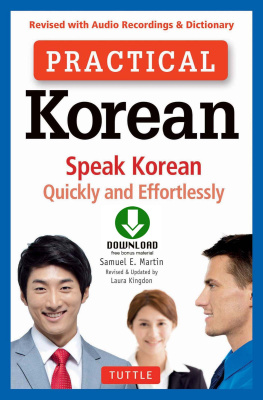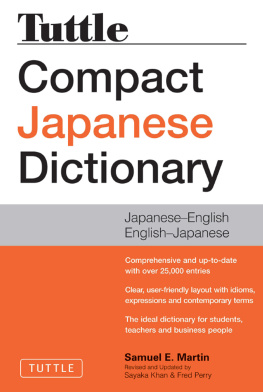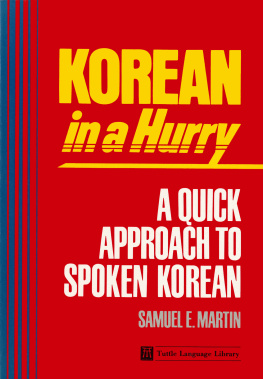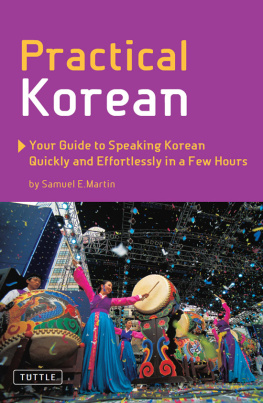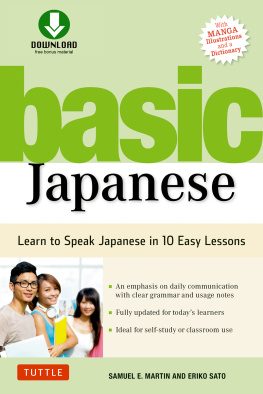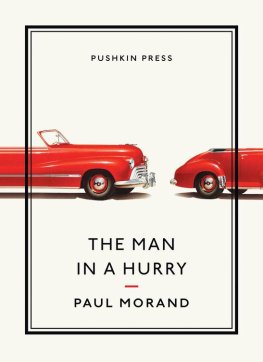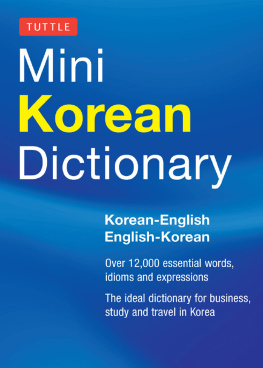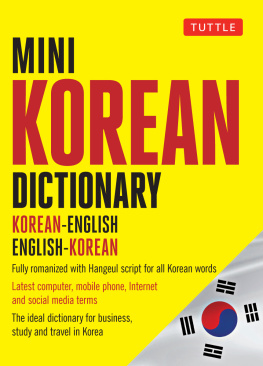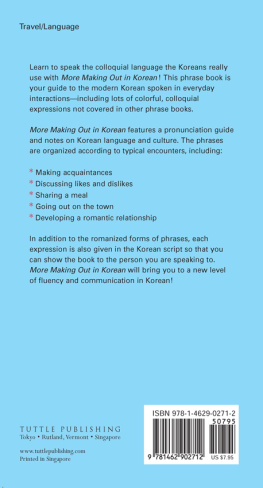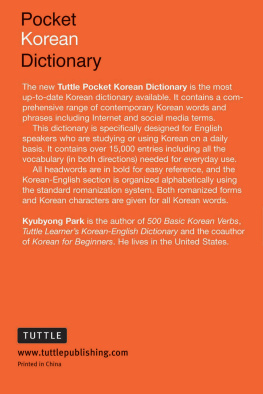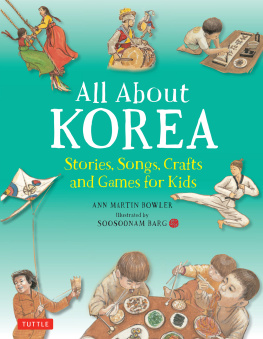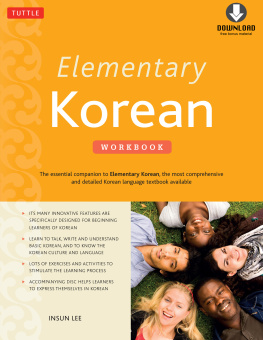Samuel E. Martin - Korean in a Hurry
Here you can read online Samuel E. Martin - Korean in a Hurry full text of the book (entire story) in english for free. Download pdf and epub, get meaning, cover and reviews about this ebook. publisher: Tuttle Publishing, genre: Detective and thriller. Description of the work, (preface) as well as reviews are available. Best literature library LitArk.com created for fans of good reading and offers a wide selection of genres:
Romance novel
Science fiction
Adventure
Detective
Science
History
Home and family
Prose
Art
Politics
Computer
Non-fiction
Religion
Business
Children
Humor
Choose a favorite category and find really read worthwhile books. Enjoy immersion in the world of imagination, feel the emotions of the characters or learn something new for yourself, make an fascinating discovery.
- Book:Korean in a Hurry
- Author:
- Publisher:Tuttle Publishing
- Genre:
- Rating:3 / 5
- Favourites:Add to favourites
- Your mark:
- 60
- 1
- 2
- 3
- 4
- 5
Korean in a Hurry: summary, description and annotation
We offer to read an annotation, description, summary or preface (depends on what the author of the book "Korean in a Hurry" wrote himself). If you haven't found the necessary information about the book — write in the comments, we will try to find it.
Korean in a Hurry — read online for free the complete book (whole text) full work
Below is the text of the book, divided by pages. System saving the place of the last page read, allows you to conveniently read the book "Korean in a Hurry" online for free, without having to search again every time where you left off. Put a bookmark, and you can go to the page where you finished reading at any time.
Font size:
Interval:
Bookmark:
by the same author
ESSENTIAL JAPANESE
EASY JAPANESE
BASIC JAPANESE CONVERSATION
DICTIONARY
CONTENTS
Lesson | |
Lesson | |
Lesson | |
Lesson | |
Lesson | |
Lesson | |
Lesson | |
Lesson | |
Lesson | |
Lesson | |
Lesson | |
Lesson | |
Lesson | |
Lesson | |
Lesson | |
Lesson | |
Lesson | |
Lesson | |
Lesson | |
Lesson | |
Lesson | |
Lesson | |
Lesson | |
Lesson | |
Lesson | |
Lesson | |
Lesson | |
Lesson | |
Lesson | |
Lesson | |
Lesson | |
Lesson | |
Lesson | |
Lesson | |
Lesson | |
Lesson | |
Lesson | |
Lesson | |
Lesson | |
Lesson | |
Lesson | |
Lesson | |
Lesson | |
Lesson | |
Lesson | |
Lesson | |
Lesson | |
Lesson | |
Lesson | |
Lesson |
Published by Tuttle Publishing, Japan
Copyright in Japan 1951
by Tuttle Publishing
All rights reserved
Library of Congress Card No. 60-8363
ISBN 0-8048-0349-8
ISBN 978-1-4629-1702-0 (ebook)
First edition, 1954
Second (revised) edition, 1960
Thirty-eighth printing, 2000
www.tuttlepublishing.com
Printed in Singapore

KOREAN IN A HURRY
INTRODUCTION
THIS BOOK has been written to fill a specific need: that of the thousands of foreign servicemen and civilians stationed in Korea for a year or two who wish to learn something of the language spoken around them. The structure of Korean is peculiarly complex, and difficulties plague the foreign student from the very beginning. I have attempted to simplify some of the common problems and to acquaint the reader with the most useful way to say a lot of everyday things.
The sentences are almost all given in the Polite (- yo) style, which is both the simplest and the most widely useful. From this style, another common. stylethe Intimateis easily derived simply by dropping the final particle. Koreans who look at the book will miss the Formal ( -smnida ) style which they feel more appropriate to use with foreigners on first acquaintance. My purpose in sticking to one style is to provide the reader with the means to say a great many different things, rather than teach him a great many ways to say the same thing. From an academic point of view, this approach has certain drawbacks. From the practical point of view, it is the quickest and simplest way to put the foreigner into direct communication with Koreans, and that is the aim of this book.
The material is presented in the original McCune-Reischauer Romanization so that it may be used in conjunction with Joan V. Underwoods Concise English-Korean Dictionary Romanized. This system contains a number of features which make the rather complicated structure of Korean grammar seem even more difficult than it is. The McCune-Reischauer Romanization is based on an attempt to use common English values of letters to represent Korean sounds in terms of the raw impressions they make on an American ear. This system was influenced by the Wade-Giles Romanization of Chinese and the Hepburn Romanization of Japanese. Both of these Romanizations have certain shortcomings (particularly the Chinese one), but the shortcomings do not stand out as sore thumbs in the way those of the McCune-Reischauer Romanization do, because the systems of sounds and sound changes of Chinese and Japanese are so much simpler than those of Korean. The excuse for using this rather cumbersome system here is that is seems to be favored by the person who has time for only a quick brush with the language. I have tried to simplify the use of the McCune-Reischauer system to some extent by generous word division and by showing automatic sound changes only within words. If the reader plans to go on with his study of Korean beyond the material contained in this book, he will probably find it advisable to do so either in the native script ( Han-gl ) or in one of the other Romanization systems shown in the table at the end of the lessons. For a scientific description of the structure of Korean, the reader is referred to the authors other publications, Korean Phonemics and Korean Morphophonemics. A comprehensive grammar is in preparation.
I hope that the material contained in this bookwhile perhaps oversimplifying a complicated languagewill be of some immediate, practical use to the reader who wants to learn some Korean in a hurry. And I hope some of those who learn Korean in a hurry will find such an interest in the language and the people who speak it that they will someday spare the time and patience needed to master the language.
Tokyo, August 1954 | S AMUEL E. M ARTIN |
NOTE TO REVISED EDITION
Since work on a Korean-English dictionary has held up the preparation of my comprehensive grammar for the past several years, it seems a good idea to put out a new edition of this little book which has met with a kinder reception than I had anticipated. I am grateful to Professor Edward C. Wagner, of Harvard University, for pointing out a number of errors; these have been corrected in this edition. Several readers have asked where they might buy my monograph Korean Morphophonemics; it is available for $2.00 from the Secretary of the Linguistic Society of America, Box 7790, University Station, Austin 12, Texas. The article Korean Phonemics appears in the anthology Readings in Linguistics, edited by Martin Joos and available for $6.00 from the Columbia University Press, 2960 Broadway, New York 27, New York.
New Haven, November 1959 | S.E.M. |
KOREAN IN A HURRY
Lesson 1
VOWELS
The vowels and combinations of y or w with a vowel are pronounced somewhat as follows:
i | as Mar i ne (meet, cheat) |
wi | as we (q uee n, bet wee n, s wee t) |
e | as m e t (or h ey s ay m a te) |
ye | as ye s (or yea man.) |
we | as we t (or way , s way , q ua ke) |
oe | usually pronounced just like we |
ae | as a t (c a p, s a ck, h a m) |
yae | as ya m |
wae | as Wa c (s wa m) |
Font size:
Interval:
Bookmark:
Similar books «Korean in a Hurry»
Look at similar books to Korean in a Hurry. We have selected literature similar in name and meaning in the hope of providing readers with more options to find new, interesting, not yet read works.
Discussion, reviews of the book Korean in a Hurry and just readers' own opinions. Leave your comments, write what you think about the work, its meaning or the main characters. Specify what exactly you liked and what you didn't like, and why you think so.

